skip to main |
skip to sidebar
Not too long ago, I started having some weird problems with my 93 525i. It usually happened right after I started the car on cooler mornings. I would drive for a bit then when I'd get to a stop, the car would have a loping idle and want to sort of surge forward. If I put the car in neutral it would take a few seconds, but the idle would smooth out. It didn't happen very often, but it was still bugging me. I hooked up my code reader and there were no codes. Thought it might be a vacuum leak somewhere, so I checked and found nothing. Then the problem stopped for several weeks.One morning I went out to go to work, cranked the starter and it wouldn't fire. Tried a few more times and it wouldn't start. Didn't have time to mess with it, so I drove my other car. The next day when I got home from work, I was going to find out what happened. I went out to the car, cranked it over and it started right up. I came away scratching my head over that.It ran fine for about another month. I had driven home from work and had to park in a place other than my normal spot because my daughter had a bunch of friends over. Later in the afternoon, they had all left so I moved the car, it ran fine. It sat there all night until I went out to drive the car to Church. I cranked it, the motor acted like it wanted to start, but quickly died and then nothing. Over time, I had found that you could hear the electric fuel pump fire up before you start the car. If I put the key to the #2 position, it would make a short whirring noise and then shut off once it pressurized the system. The morning that I tried to start it before Church, the whirring noise was more of a grinding noise. I tried starting it several more times during the day and nothing. I decided that the fuel pump was DOA. I ordered a new one the next morning from autohausaz. I had to wait to make sure that I got the correct one. Apparently there are two different versions that work on my car, so I needed to remove the old one to make sure I ordered the right one. The two versions were about $70 different in price, so I was sure that mine would be the more expensive one. I got up early and started the job. I read the Bentley manual instructions on how to remove the pump, but skipped the part where it tells you to drain the fuel tank. Probably not the best way to do it, but it's what I did. All of those reports of gas tanks exploding are greatly exaggerated, I know from experience.Anyway, the removal of the fuel pump/sending unit is fairly simple. I took some pictures and will post them with explanations below. BTW, when I took out the fuel pump, I discovered that I had the cheaper one, so I saved about $70, that doesn't normally happen to me, I always seem to be on the short end of the stick in situations like this.The fuel pump is in the fuel tank. To get to it, there is an access hole under the carpet of the trunk. Here is a picture: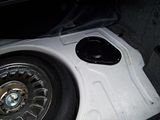 Here is a picture of it with the access cover off:
Here is a picture of it with the access cover off: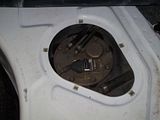 This picture is a close up of the top of the fuel pump/sending unit. To get it out, you have to remove the two fuel lines (I marked the left one with the electrical tape to make sure I put it back together right), the electrical connector and the eight mounting nuts that hold the plate to the tank. To remove the electrical connector, you have to slide the metal clip towards the back of the car. I put a small screwdriver in where I drew the green arrow and pried back and it came right off.
This picture is a close up of the top of the fuel pump/sending unit. To get it out, you have to remove the two fuel lines (I marked the left one with the electrical tape to make sure I put it back together right), the electrical connector and the eight mounting nuts that hold the plate to the tank. To remove the electrical connector, you have to slide the metal clip towards the back of the car. I put a small screwdriver in where I drew the green arrow and pried back and it came right off.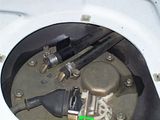 Once you have everything loose and disconnected, the plate will want to push upwards. There is enough play in the fuel lines and wiring to where you can take the sending unit out of the tank so you can get your hands on the retaining clips that hold the fuel pump in the mounts in the tank. Make sure that you make note of how everything is oriented as you remove it from the tank. The Fuel Lines from the mounting plate to the pump have to twist around the sending unit so it sits properly in the tank. I wasn't really careful when I removed mine, so it took me a bit to figure just how it went back in. I didn't take any pics of me removing the unit since no one was home when I was doing it. Here is a picture of the entire unit after I got it out of the tank:
Once you have everything loose and disconnected, the plate will want to push upwards. There is enough play in the fuel lines and wiring to where you can take the sending unit out of the tank so you can get your hands on the retaining clips that hold the fuel pump in the mounts in the tank. Make sure that you make note of how everything is oriented as you remove it from the tank. The Fuel Lines from the mounting plate to the pump have to twist around the sending unit so it sits properly in the tank. I wasn't really careful when I removed mine, so it took me a bit to figure just how it went back in. I didn't take any pics of me removing the unit since no one was home when I was doing it. Here is a picture of the entire unit after I got it out of the tank: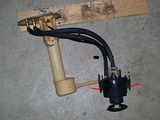 The two red arrows I drew on the last picture (click on the picture to enlarge it) show the clips that hold the pump in it's mount in the tank.This next pic show the wires connected to the old (bad) pump:
The two red arrows I drew on the last picture (click on the picture to enlarge it) show the clips that hold the pump in it's mount in the tank.This next pic show the wires connected to the old (bad) pump: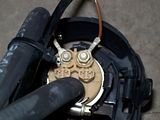 The new pump came with a different type of electrical connector, spade bits with a plastic clip the spade connectors clip in to. The pump is made by Bosch. They supplied everything you need to change the connectors except for the proper crimping tool for the job. I did my best to get them tight, but apparently my best wasn't good enough. I'll get to that in a bit. Here is a pic of the set up on the new pump. I made sure I oriented the wires the way they were on the old pump:
The new pump came with a different type of electrical connector, spade bits with a plastic clip the spade connectors clip in to. The pump is made by Bosch. They supplied everything you need to change the connectors except for the proper crimping tool for the job. I did my best to get them tight, but apparently my best wasn't good enough. I'll get to that in a bit. Here is a pic of the set up on the new pump. I made sure I oriented the wires the way they were on the old pump: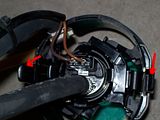 Also, note that I drew red arrows on the previous pic showing the clip locations from the top of the pump.Other than changing the wires, all you have to do is transfer the fuel lines over to the new pump. Installation is just reverse of removal. I would suggest that you replace the rubber gasket to the pump/sending unit. I took a couple of pics to show you how it goes on. I didn't pay attention when I removed the old one, so I had to play with it a bit to get it on right. There is a little indexing mark on the gasket to help you orient it right, I drew green arrows to show when it needs to be to go on correctly.This pic shows the mark:
Also, note that I drew red arrows on the previous pic showing the clip locations from the top of the pump.Other than changing the wires, all you have to do is transfer the fuel lines over to the new pump. Installation is just reverse of removal. I would suggest that you replace the rubber gasket to the pump/sending unit. I took a couple of pics to show you how it goes on. I didn't pay attention when I removed the old one, so I had to play with it a bit to get it on right. There is a little indexing mark on the gasket to help you orient it right, I drew green arrows to show when it needs to be to go on correctly.This pic shows the mark: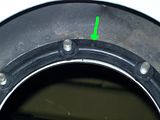 This one shows where it needs to be installed to fit properly (just to the right of the bolt):
This one shows where it needs to be installed to fit properly (just to the right of the bolt): Once you have everything back in and secured, make sure you torque the nuts to 89 inch pounds. I then tried to start the car, but nothing. I tried a couple of more times, but it wouldn't start. I took the pump back out and found that I hadn't done such a good job of crimping the wires, one had come loose when I put it back in the tank. I tried to get the spade connectors out of the little plastic clip without damaging them, but was not successful. I ended up buying some solderless connectors of the same type at Radio Shack and put them on. The plastic clip was no good any longer, but the spade connectors were really tight once I put them on the spades.I put everything back together and tried again, NOTHING. Cranked but no fire. The only other thing that I could think of that could be wrong was that the wires were not hooked up to the right terminals. I took everything back apart, switched the wires, put it back together, and SUCCESS. After being so careful to get the wires in the right position, Bosch swapped the terminal locations. I read through all of the installation material that came with the new pump and there was no mention of any wiring changes at all. At least it works now, and it seems to actually run a bit stronger than before. I think maybe the old pump was weak before it finally gave up.Good Luck if you try this, it isn't really very hard. If things had gone right the first time, the whole job would have taken me about an hour. One other thing, I changed out the fuel filter while I was at it. They recommend doing so in the installation paperwork that comes with the pump.
Once you have everything back in and secured, make sure you torque the nuts to 89 inch pounds. I then tried to start the car, but nothing. I tried a couple of more times, but it wouldn't start. I took the pump back out and found that I hadn't done such a good job of crimping the wires, one had come loose when I put it back in the tank. I tried to get the spade connectors out of the little plastic clip without damaging them, but was not successful. I ended up buying some solderless connectors of the same type at Radio Shack and put them on. The plastic clip was no good any longer, but the spade connectors were really tight once I put them on the spades.I put everything back together and tried again, NOTHING. Cranked but no fire. The only other thing that I could think of that could be wrong was that the wires were not hooked up to the right terminals. I took everything back apart, switched the wires, put it back together, and SUCCESS. After being so careful to get the wires in the right position, Bosch swapped the terminal locations. I read through all of the installation material that came with the new pump and there was no mention of any wiring changes at all. At least it works now, and it seems to actually run a bit stronger than before. I think maybe the old pump was weak before it finally gave up.Good Luck if you try this, it isn't really very hard. If things had gone right the first time, the whole job would have taken me about an hour. One other thing, I changed out the fuel filter while I was at it. They recommend doing so in the installation paperwork that comes with the pump.
Hopefully you are reading this to help you figure out how to get those darn gauges, speedometer and tachometer working on your Cavalier. I'm writing a "How To" with pictures to help you out. If you don't know how to get your dash apart, I wrote that up too, just go to the blog post I wrote just before this one.
MAKE SURE YOU READ THIS ALL THE WAY THROUGH BEFORE STARTING THE JOB, JUST SO YOU DON'T GET AHEAD OF YOURSELF.
So to this point, you should have your Instrument Cluster in your hot little hands. Here is a picture of what it looks like out of the car, before taking it apart to get to the circuit board.
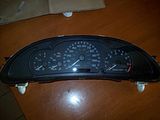 I regret that I forgot to take some pictures of the clips that hold the Cluster together, but once you have yours out of the car, you should be able to figure out how to get it apart. It is pretty obvious.
The main reason the gauges, speedometer and tachometer fail on these cars is due to faulty "Stepper Motors". Long gone is the day of speedometer and tachometer cables and real gauges that took information from sending units. All of that information nowadays is sent by electrical impulses to the Stepper Motor and then displayed on your Cluster.
This is a picture of what the Stepper Motor looks like. The one on the left is the Updated replacement to the one on the right. You can see the GM part number for the new motor... X25.168.
I regret that I forgot to take some pictures of the clips that hold the Cluster together, but once you have yours out of the car, you should be able to figure out how to get it apart. It is pretty obvious.
The main reason the gauges, speedometer and tachometer fail on these cars is due to faulty "Stepper Motors". Long gone is the day of speedometer and tachometer cables and real gauges that took information from sending units. All of that information nowadays is sent by electrical impulses to the Stepper Motor and then displayed on your Cluster.
This is a picture of what the Stepper Motor looks like. The one on the left is the Updated replacement to the one on the right. You can see the GM part number for the new motor... X25.168.
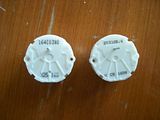 These shots of the Stepper Motors give you a better idea of what they look like.
Front side showing the shaft that the needle attaches to.
These shots of the Stepper Motors give you a better idea of what they look like.
Front side showing the shaft that the needle attaches to.
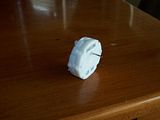 Rear side showing the two white indexing pins and the four wires you solder to the PCB (printed circuit board).
Rear side showing the two white indexing pins and the four wires you solder to the PCB (printed circuit board).
 Now for the repair steps.
Once you have removed the clear plastic front to the cluster and the back cover that protects the circuit board this is what you will see.
Now for the repair steps.
Once you have removed the clear plastic front to the cluster and the back cover that protects the circuit board this is what you will see.
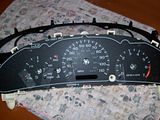
 You can see on the face of the gauges in the previous pictures that I have placed tape near the starting point for the gauges, speedometer and tachometer. This is done to mark the location of the needles prior to pulling them off of the Stepper Motor Shaft. I couldn't find any masking tape, so I used Scotch Tape. Just make sure you can write on the tape. To get the needles to the correct position, you turn them slowly and gently counter clockwise until they stop. That should be the starting or resting point for them. Once you have all the needles to that position, go ahead and mark the needle position on the tape you stuck to the gauge faces.
Here is a close up of my son's cluster so you can see the marks I made. I wish I had taken a photo or two of the cluster prior to removing the needles so you could see how bad they were. The Temperature and Fuel gauge were pointing to the six o'clock position and the Speedometer was registering about 45 mph when the car was parked and not running. The only gauge working was the Tachometer.
You can see on the face of the gauges in the previous pictures that I have placed tape near the starting point for the gauges, speedometer and tachometer. This is done to mark the location of the needles prior to pulling them off of the Stepper Motor Shaft. I couldn't find any masking tape, so I used Scotch Tape. Just make sure you can write on the tape. To get the needles to the correct position, you turn them slowly and gently counter clockwise until they stop. That should be the starting or resting point for them. Once you have all the needles to that position, go ahead and mark the needle position on the tape you stuck to the gauge faces.
Here is a close up of my son's cluster so you can see the marks I made. I wish I had taken a photo or two of the cluster prior to removing the needles so you could see how bad they were. The Temperature and Fuel gauge were pointing to the six o'clock position and the Speedometer was registering about 45 mph when the car was parked and not running. The only gauge working was the Tachometer.
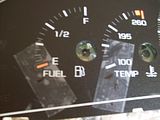 Once you have the needle positions marked on the tape, it is time to remove the needle from the shaft of each Stepper Motor. The instructions I followed were included with the motors I got on Ebay. Take each needle and turn it slowly counter clockwise until you feel it break loose from the Stepper Motor shaft. Don't worry, it shouldn't break, mine didn't. Once all of the needles are loose, take a Dinner Fork and place it under the base of the needle. Slowly and gently pull up on the needle to get it off of the shaft. It's a bit scary, I know, but it works just as I've written it. Remember which needle came off of which gauge so you put them back on the way they were.
You should be able to pull the cluster face off now. I didn't get a picture of the side of the PCB with the Motors on it. It's not really important since you work off the back side when removing the motors.
The following pictures show you the locations of the Stepper Motors on the business side of the board (soldered joints).
Once you have the needle positions marked on the tape, it is time to remove the needle from the shaft of each Stepper Motor. The instructions I followed were included with the motors I got on Ebay. Take each needle and turn it slowly counter clockwise until you feel it break loose from the Stepper Motor shaft. Don't worry, it shouldn't break, mine didn't. Once all of the needles are loose, take a Dinner Fork and place it under the base of the needle. Slowly and gently pull up on the needle to get it off of the shaft. It's a bit scary, I know, but it works just as I've written it. Remember which needle came off of which gauge so you put them back on the way they were.
You should be able to pull the cluster face off now. I didn't get a picture of the side of the PCB with the Motors on it. It's not really important since you work off the back side when removing the motors.
The following pictures show you the locations of the Stepper Motors on the business side of the board (soldered joints).
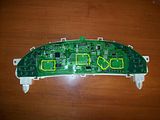
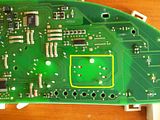 The first picture shows location of the four motors, see the yellow outlines. (If you want to see larger pictures, just click on whatever picture you want to see larger and you will see the larger size.) If you look closely, you can see the outlines of the motors through the PCB.
The second picture is just a close up of one of the motors on the board. You can see the outline of the motor more clearly in this picture. You can also see the two indexing pins that locate the motor properly on the PCB. I put a little red dot next to the soldering points on the PCB for the motor. These are the spots you will need to work on. It is quite easy to locate these spots for each of the four motors if you have the PCB in front of you.
Now all you have to do is remove the motors and solder in the new ones. I know, it sounds like a tough job, but it really isn't. I have a very basic knowledge of soldering and it only took me about 20 minutes to do the job.
What you have to have to complete the job is a soldering iron and some way to de-solder the joints. I bought a De-soldering Iron at Radio Shack for $11. It is extremely easy to use and makes the job a snap. I would guess it took me less than five minutes to remove all of the motors from the PCB using the De-soldering Iron.
The first picture shows location of the four motors, see the yellow outlines. (If you want to see larger pictures, just click on whatever picture you want to see larger and you will see the larger size.) If you look closely, you can see the outlines of the motors through the PCB.
The second picture is just a close up of one of the motors on the board. You can see the outline of the motor more clearly in this picture. You can also see the two indexing pins that locate the motor properly on the PCB. I put a little red dot next to the soldering points on the PCB for the motor. These are the spots you will need to work on. It is quite easy to locate these spots for each of the four motors if you have the PCB in front of you.
Now all you have to do is remove the motors and solder in the new ones. I know, it sounds like a tough job, but it really isn't. I have a very basic knowledge of soldering and it only took me about 20 minutes to do the job.
What you have to have to complete the job is a soldering iron and some way to de-solder the joints. I bought a De-soldering Iron at Radio Shack for $11. It is extremely easy to use and makes the job a snap. I would guess it took me less than five minutes to remove all of the motors from the PCB using the De-soldering Iron.
Here is a picture of the De-soldering Iron.
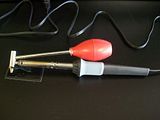
As you can see, it is nothing more than a soldering iron with a suction bulb attached. You squeeze the bulb, put the tip on the joint, let it heat for about 3-4 seconds and let the bulb go and remove the tip. Very simple. Just follow the instructions with the Iron. Also, there are several very good de-soldering videos on youtube you can watch, I found several, so go there and look if you want more information.
Once you have all the motors removed, you need to get the new motors in place for soldering. Make sure the wire pins go into their respective holes without folding under. They need to be sticking out through the holes to solder them in place. Just take your time, it isn't hard. Once the new motors are back in place, solder them all up. Again, youtube has several good soldering videos to help you out. I bought a nice little 30w Iron at Harbor Freight for $4 and it worked perfectly.
Here is a picture of the one I bought.
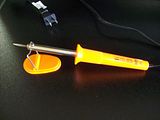
Make sure you have a pencil type tip, it makes it easier to get around those small joints. Here is a close up of the pencil tip:
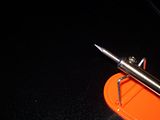
When soldering on a PCB, use 60/40 ROSIN core solder. Do NOT use acid core solder unless you want to ruin your circuit board. I bought some .032" solder. The smaller diameter makes it melt quicker, not as much mass to heat up.
This is the solder I used:
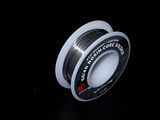 The soldering probably took me about 10 minutes or so to complete.
Once the soldering is done, you can put the Cluster back together. Just reverse the steps you did to take it apart. When you are ready to put the gauge needles back on, here is how you do it.
Put the needle on the shaft at the 12 o'clock position and push it on. Once they are all installed, turn the needle counter clockwise until you line up the needle with the mark you made on the tape. When you get to the mark, stop. That should be where each needle is at rest. You can put the rest of the cluster back together and get ready to put it back into the car.
As I stated in my previous blog entry on removal of the Dash on the Cavalier. I removed the fuses for the Instrument Cluster and the Air Bags. If you didn't follow my instructions regarding the Dash, I would suggest you remove those two fuses just to be safe.
Now, go out to the car and put the Cluster back where it is supposed to be and hook up the plug to the back. Now, put the Instrument Cluster fuse back in and you should see your needles set themselves to their resting points. If everything looks good, go ahead and put everything back together. When we did this on my son's car, the Speedometer was reading about 1 mph. We pulled the fuse, removed the cluster and opened it up. Moved the needle a little bit more counter clockwise and then put it back together. This time it was in the right spot.
We finished up by putting the dash back together and then starting the car. Everything seemed to be working correctly. Here is a picture of the Cluster while we were driving around checking it out.
The soldering probably took me about 10 minutes or so to complete.
Once the soldering is done, you can put the Cluster back together. Just reverse the steps you did to take it apart. When you are ready to put the gauge needles back on, here is how you do it.
Put the needle on the shaft at the 12 o'clock position and push it on. Once they are all installed, turn the needle counter clockwise until you line up the needle with the mark you made on the tape. When you get to the mark, stop. That should be where each needle is at rest. You can put the rest of the cluster back together and get ready to put it back into the car.
As I stated in my previous blog entry on removal of the Dash on the Cavalier. I removed the fuses for the Instrument Cluster and the Air Bags. If you didn't follow my instructions regarding the Dash, I would suggest you remove those two fuses just to be safe.
Now, go out to the car and put the Cluster back where it is supposed to be and hook up the plug to the back. Now, put the Instrument Cluster fuse back in and you should see your needles set themselves to their resting points. If everything looks good, go ahead and put everything back together. When we did this on my son's car, the Speedometer was reading about 1 mph. We pulled the fuse, removed the cluster and opened it up. Moved the needle a little bit more counter clockwise and then put it back together. This time it was in the right spot.
We finished up by putting the dash back together and then starting the car. Everything seemed to be working correctly. Here is a picture of the Cluster while we were driving around checking it out.
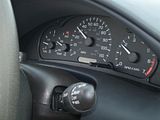 As you can see, everything seemed to be working properly. We used a GPS to make sure the Speedometer was working right and it was right on.
This little repair could cost you upwards of $500 if you have someone repair it for you. Even with buying the Soldering Iron, De-Soldering Iron, Solder and Motors, we had just under $60 into the repair.
Good Luck if you try this out.
As you can see, everything seemed to be working properly. We used a GPS to make sure the Speedometer was working right and it was right on.
This little repair could cost you upwards of $500 if you have someone repair it for you. Even with buying the Soldering Iron, De-Soldering Iron, Solder and Motors, we had just under $60 into the repair.
Good Luck if you try this out.
An FYI... This is part one of a two part blog entry. The second part will cover how I repaired the Instrument Cluster on the 05 Cavalier.I really enjoy using the Internet. You can find all sorts of information about all kinds of things. I spent several hours surfing and searching for information on how to remove the dashboard on a 2005 Chevy Cavalier, but couldn't find a good step by step instruction on how to do it. Hence this blog entry.
The reason I wanted to know how to do it was so I could remove the Instrument Cluster to repair the Speedometer, Fuel and Temperature gauges on the car.The car belongs to my son. We were talking one day and he said that his Speedometer had stopped working, along with the Fuel and Temp gauges. One thing lead to another and I was on the Internet looking for fixes. I first came across some guys who talked about the "Stepper Motors" being bad. Apparently, GM used a very bad batch of these "Stepper Motors" in a whole bunch of cars, not just the Cavalier. I located some Speedometer Repair services on Ebay that offered their services for $90 and up. The $90 service was just to repair one Stepper Motor, if you wanted more done, it was at least $10 per motor more. I kept on looking and found some decent "How to" sites that gave a bit of information on how to do the repair for yourself. I'm all into that (just read through more of my blog posts about my other adventures with my BMW's). So I decided to try and do this myself. I found a seller on Ebay that was selling the upgraded GM "Stepper Motors" for a decent price. I needed four to do the job... replacing the bad Speedometer, Fuel and Temp gauge and just so I wouldn't have to do it again, I would replace the Tachometer motor also, even though it was still working.Once the Motors arrived, I had everything I needed, except for good instructions on how to get the Instrument Cluster out of the car. Now, there will be these instructions for you to use if you need to take yours apart.The first thing you need to do is locate all of the screws that hold the top of the dash in place. Below are some pictures I took of their locations. Just follow the comments I put at the top of each picture.I started by removing the end trim pieces of the dash.This is the drivers side end. In the picture you can see the two yellow arrows, these are the trim pieces that just pry off. There is a screw in the green circle that has to be removed. The three red circles show the mounting points for the large trim piece. The small trim piece is actually the door to the fuse box.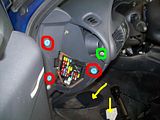 This next picture is the end on the passenger side of the car. The screw in the green circle needs to come off. The mounting spots for the trim on this side are those blue receptacles. The trim just pulls off.
This next picture is the end on the passenger side of the car. The screw in the green circle needs to come off. The mounting spots for the trim on this side are those blue receptacles. The trim just pulls off.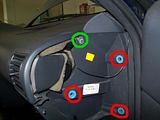 The next screws I removed came from the glove box area. Open the glove box and you will see two screws near the upper edge of the box, circled in green in the picture. You need to remove these.
The next screws I removed came from the glove box area. Open the glove box and you will see two screws near the upper edge of the box, circled in green in the picture. You need to remove these.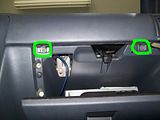 It's hard to get a full shot of the plastic bezel that you are removing to get to the cluster when it's still in the car. Here is a shot of it removed, so you can see what has to come out.
It's hard to get a full shot of the plastic bezel that you are removing to get to the cluster when it's still in the car. Here is a shot of it removed, so you can see what has to come out.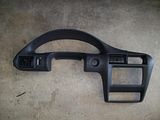 Just so you know, in the bezel picture, there are two plugs you have to disconnect to completely get it out of the car. If you look at near the center of the bezel you will see a small round hole, that is where the Cigarette lighter fits. There is a plug to it. There is a plug to the light dimmer switch also that has to be removed. Both plugs have little retaining clips you have to manipulate to unplug them.There are still two more screws that you will need to remove before the bezel can come out. These two screws are located on either side of the Instrument Cluster on the top. In the pictures you can see their locations. The one on the right side is a bit of a bear to get out.This is the left side of the bezel. The screw is located inside where I drew the red circle (the other circles will be explained later). This screw installs from the top, so you have to make sure that the other screws and clips are loose so you can get to this one.
Just so you know, in the bezel picture, there are two plugs you have to disconnect to completely get it out of the car. If you look at near the center of the bezel you will see a small round hole, that is where the Cigarette lighter fits. There is a plug to it. There is a plug to the light dimmer switch also that has to be removed. Both plugs have little retaining clips you have to manipulate to unplug them.There are still two more screws that you will need to remove before the bezel can come out. These two screws are located on either side of the Instrument Cluster on the top. In the pictures you can see their locations. The one on the right side is a bit of a bear to get out.This is the left side of the bezel. The screw is located inside where I drew the red circle (the other circles will be explained later). This screw installs from the top, so you have to make sure that the other screws and clips are loose so you can get to this one.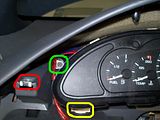 This is the right side of the bezel. The screw is located where I drew the red circle (same thing about the other circles). This screw also installs from the top. I would suggest that this be the last screw you remove, since it's the hardest to get to.
This is the right side of the bezel. The screw is located where I drew the red circle (same thing about the other circles). This screw also installs from the top. I would suggest that this be the last screw you remove, since it's the hardest to get to.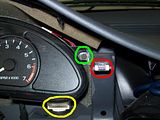 All of these screws use a 7mm socket. The rest of the bezel is just pried off. I used two different sized putty knives to do the prying. You have to pry up around the cluster to get to the last two screws. These two pics show the clips (same clips, just different camera angles) that need to come out to get to the screws (green circles).
All of these screws use a 7mm socket. The rest of the bezel is just pried off. I used two different sized putty knives to do the prying. You have to pry up around the cluster to get to the last two screws. These two pics show the clips (same clips, just different camera angles) that need to come out to get to the screws (green circles).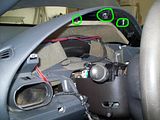
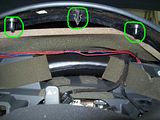 By getting these clips released and up, it makes it much easier to get to the screws. Just make sure to remove the other screws first.These pictures give you an idea of where the clips are located along the whole bezel.This picture shows the area around the radio and climate control unit. The red arrow is a clip that was a bit difficult to see even with everything else loose. I put a screwdriver in behind the bezel at that point and pried outward and it finally released. The two green arrows are clips that released fairly easy. The yellow arrow points to the location of the last screw on the right side of the Cluster.
By getting these clips released and up, it makes it much easier to get to the screws. Just make sure to remove the other screws first.These pictures give you an idea of where the clips are located along the whole bezel.This picture shows the area around the radio and climate control unit. The red arrow is a clip that was a bit difficult to see even with everything else loose. I put a screwdriver in behind the bezel at that point and pried outward and it finally released. The two green arrows are clips that released fairly easy. The yellow arrow points to the location of the last screw on the right side of the Cluster.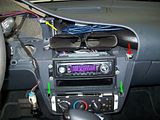 This picture shows all of the various clips, mounting points and screw positions on top of the bezel from the top. All of the circled parts are involved in securing it to the dash.
This picture shows all of the various clips, mounting points and screw positions on top of the bezel from the top. All of the circled parts are involved in securing it to the dash.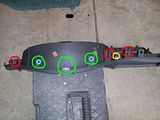 Once all of the clips and screw are out or released, you only have one more thing to do to get the bezel out. You need to remove the top plastic cover to the steering wheel. If you look between your steering wheel and the bezel, there is a plastic cover where the "Emergency Flasher" button sticks out. This is a two piece cover that is split down the side so it can be removed if necessary. Find the joint where it connects and use one of your putty knives to open it, sort of like a clam. It popped right open with very little pressure on my son's car. Pull the top off and you should then be able to get the bezel out. You have to sort of finesse it out, but it does come out. Make sure you remove the two plugs for the Cig Lighter and Dimmer switch.That takes care of removing the bezel. This next part is a bit easier and only takes a few minutes.There are two screws that hold the Cluster in place. Here are those two pictures from before that I said I would explain about the other circles. The green circles show the location of the screws that need to be removed to get the Cluster out. The yellow circles show the mounting points on the bottom of the cluster. If you look closely, you can see two white pieces that are nipples on the Cluster that locate the Cluster in the opening of the bezel. The nipples fit in holes in the dash.
Once all of the clips and screw are out or released, you only have one more thing to do to get the bezel out. You need to remove the top plastic cover to the steering wheel. If you look between your steering wheel and the bezel, there is a plastic cover where the "Emergency Flasher" button sticks out. This is a two piece cover that is split down the side so it can be removed if necessary. Find the joint where it connects and use one of your putty knives to open it, sort of like a clam. It popped right open with very little pressure on my son's car. Pull the top off and you should then be able to get the bezel out. You have to sort of finesse it out, but it does come out. Make sure you remove the two plugs for the Cig Lighter and Dimmer switch.That takes care of removing the bezel. This next part is a bit easier and only takes a few minutes.There are two screws that hold the Cluster in place. Here are those two pictures from before that I said I would explain about the other circles. The green circles show the location of the screws that need to be removed to get the Cluster out. The yellow circles show the mounting points on the bottom of the cluster. If you look closely, you can see two white pieces that are nipples on the Cluster that locate the Cluster in the opening of the bezel. The nipples fit in holes in the dash.
 Prior to removing the Cluster I removed the fuses for the Instrument Cluster and the Air Bags, just to make sure I didn't short something out. Make sure you put them back it once you have everything put back together.Once the screws are removed, you can tilt the top of the Cluster towards you and it will start to come out. Manipulate it a bit and you can get the nipples out of the holes. Once it's clear, you just have to unclip the plug to the Cluster that is located at the center/top of the Cluster.That does it for this part. I will blog another post soon about the actual repair of the cluster.
Prior to removing the Cluster I removed the fuses for the Instrument Cluster and the Air Bags, just to make sure I didn't short something out. Make sure you put them back it once you have everything put back together.Once the screws are removed, you can tilt the top of the Cluster towards you and it will start to come out. Manipulate it a bit and you can get the nipples out of the holes. Once it's clear, you just have to unclip the plug to the Cluster that is located at the center/top of the Cluster.That does it for this part. I will blog another post soon about the actual repair of the cluster.
Back when I bought the 93 525i, I was surprised at how much sludge build up there was on the underside of the valve cover when I was replacing the gasket. It took me a couple of hours to scrape and clean all of that gunk off. I used a strong degreaser and then power washed it. Even with all of that, it still had some baked on varnish and other deposits that wouldn't come off. I figured if the valve cover was that bad, the inside of the motor had to look pretty bad too. So I changed the oil and filter and ran a quart of MMO (Marvel Mystery Oil) in it for about 500 miles. I then changed the oil again, using some high dollar crankcase flush I bought specifically for BMW's. When I drained that oil, it was pretty dirty for only being in there for 500 miles.I refilled with new oil and a filter at the viscosity recommended in the owners manual. When I did that, I noticed a very loud lifter noise on start up that would go away after a few seconds. I figured it was just a sticky lifter. As the weather turned cold, the duration of the lifter noise became longer and louder. I decided to run some lighter weight oil for the winter months and it helped with the lifter noise. It was still there, but not too bad even in really cold weather (at least for where I live). The car wasn't being driven more than about 3 to 4 hundred miles a month by my son. So this oil change lasted almost a year. I started driving it to work when he left home for bigger and better things instead of driving my SUV and putting so many miles on it. Some days it wouldn't make any noise, some days a little.I decided to do some research on ways to possibly get rid of the noise. I found some interesting message board posts on various boards that talked about MMO and another additive called Auto RX. I had tried the MMO and it didn't seem like it had done much before. The Auto RX (ARX) had some pretty convincing testimonials that I was reading. I looked for negative remarks but really couldn't find any so I decided to try it for myself. I ordered enough to do two of my vehicles and will keep a log of what happens with my 93 E34 for all to view.Today, I received my order of ARX and put it into the cars I wanted to treat. Since there was no reason for me to open up the valve cover on the 93, I did find some varnish build up under the lid to the oil filter housing and inside the oil filter housing (see attached pictures). The ARX claim is that it will removed these harmful buildups of sludge, varnish and other contaminants "layer by layer". I will take more pictures when I change the oil to flush out the treatment in 3K miles. I'm hoping that there will be an improvement in performance and also in mileage. That's what they claim. On this car, they state that it will need to go through two complete treatments to get the best results due to the mileage.If I notice anything performance wise or mileage wise, I will make note of it during the 3K mile treatment phase.Here are the pictures I referred to:This one is the underside of the oil filter housing lid This one is the inside of the oil filter housing
This one is the inside of the oil filter housing
I actually figured this out several months ago, but actually forgot that I had said I would update it if I found the problem.A while back I wrote that I had noticed a strange thumping sound while driving the 93 525i. I looked all over the car and couldn't find the noise, so I just sort of forgot about it. One day in early summer, I decided to get the tires replaced that had worn sort of weird before I got the front end fixed up. On the way home from the tire shop, I made a left hand turn and it felt like the right front tire was coming off. I stopped real quick and checked, but everything looked fine. When I got home, I jacked up the front end and that's when I found the problem.I hate to admit it, but when I changed out the front struts, I must not have screwed the retaining cap to the insert down. Either that or it came loose somehow (highly unlikely since they are very long winded threads). When I looked at that wheel, it was hanging about six to eight inches lower that the other side and you could see the retaining cap just sitting there, the only thing holding the strut together was the spring. I figured that I had trashed the whole set up and started taking it apart. Once I got it all apart it appeared that everything was fine, so I put it all back together. It's been working fine since, no more thumping.I said that I wasn't a professional mechanic and I just proved it by this little gaffe. I still enjoy working on the cars though.
Back in the earlier part of the summer this year, I noticed that the 93 525i that my son drives had this annoying cracking sound every time the drivers door was opened. I went out and checked and found that the mounting area for the door brake was all cracked. It mounts inside of the door with the arm of it attaching to the door jam. The door brake is what keeps the door from opening to far and keeps it from closing on its own if you want it to stay open. The sheet metal was tearing and deformed. I didn't take any pictures at the time, but the brake was trying to pull its way through the sheet metal. I didn't have time to mess with it, so I took a ball peen hammer and bent the sheet metal back to near its original position. It still made noise, but at least it wasn't going to pull itself out.
For the next few months, I was kept pretty busy at work and didn't have the time to fix this problem. I thought about it a few times when I heard the pop and crack when the door was opened. I started thinking about ways that I could fix it. Most of them included some kind of welding, but I don't weld.
A couple of days ago, I finally found the time to tackle the job. I came up with a repair that only cost me six dollars and I didn't have to weld anything.
Here is a picture of the problem before I started working on it:
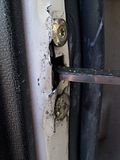
Here is what it looked like once I took off the door panel and could get to the door brake and remove it:
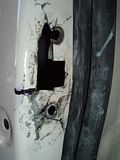
Picture of the removed door brake:
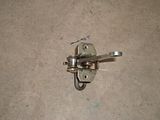
My idea for the repair was to get some metal and make a mounting plate for the door brake and then pop rivet it to the outside of the door to make the area stronger. I decided to get a piece of flat plate metal that was 1 1/2" wide and 1/8" thick. I had to buy a 36” long piece, but it only cost six dollars. After looking at what I needed to cover, I cut the metal 7” long. I took my time and laid it out the best I could and cut it and drilled it. I know it doesn't look very professional, but it works, here is a picture:

Here is a picture of the door brake mounted to the plate I made before I installed it, just to see if it fit properly:
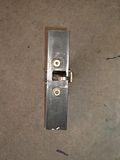
I didn't have any special tools other than my cordless drill and a jig saw with a metal cutting blade to do the drilling and cutting. I do have an old bench grinder that I used to smooth all the rough edges.
To be able to mount the door brake back on the door, I needed to remove most of the cracked and torn metal. Here is what it looked like once I did that:
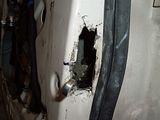
To get the metal out of the way, I used one of those hand held air operated cut off wheels. I initially tried using some tin snips, but the cut off wheel worked much faster. I left as much metal on the door as I could and still be able to get the door brake mounted. I wanted to leave the metal there to add some backing to the plate I made.
I did most of the work with the door still on the car. I figured out though that I wouldn't be able to drill the door jam for the pop rivets if I didn't remove the door. It only took me about 10 minutes to remove the door, I should have done that before I started this whole project and would suggest if you're planning on doing this to take the door off first. It makes everything much easier.
I ended up having to modify the shape of the plate to get it to lay flat and to avoid sharp corners. I rounded off all four corners. The upper corner towards the outside of the door I took more off so it would fit better. Once I was happy with the way it fit, I decided where I would drill the holes for the pop rivets. I put three on the top and four on the bottom mainly due to the shape of the door. I filed and ground down the remaining rough spots, sanded the plate and painted it to protect against rust.
Once the paint was dry, I went to install it. This is where having the door off of the car really helped. I positioned the door brake where I needed it to be and found that some of the rubber weather stripping on the door was in the way. I used a utility knife to trim away just a bit of the weather stripping and then the plate laid perfectly flat. With it in the correct position, I then drilled all the pop rivet holes and installed them.
Here is a picture of the plate riveted in place with the door brake installed:
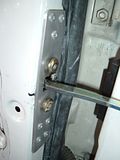
This last picture shows everything installed with the rubber boot in place:
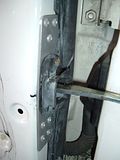
That's it! I used the Bentley Manual for instructions on how to remove the door panel, how to remove the door brake and how to remove the door. While I was in the door, I lubed all of the door parts and the moving window parts that needed it. Done!
For a 16 year old car that had a bunch wrong with it when I bought it, it is holding up fairly well considering how it's being used. My son uses it to deliver Pizza's. Haven't done anything to it for several months other than put gas in it.A couple of weeks ago, I got a phone call from my wife while I'm at work telling me that the fuel door fell off of the car. I knew that it was a common problem on the E34 and didn't think too much about it. I knew a new hinge wasn't too costly, so I wasn't fretting fixing it. The next day when I got home, I checked and found that the hinge had broken. I ordered a new one from Autohaus, the shipping was almost as much as the hinge itself.This first picture shows all of the pieces it broke into while I removed it. It was pretty much intact until I had to break all of the plastic out of the two mounting brackets mounted on the car. Apparently someone in the past had a difficult time replacing the hinge and just glued it in place. You can see the glue residue (arrows) around the square mount holes in this picture. I cleaned it up to this point and just waited for the new hinge to arrive. It came a few days later.
Apparently someone in the past had a difficult time replacing the hinge and just glued it in place. You can see the glue residue (arrows) around the square mount holes in this picture. I cleaned it up to this point and just waited for the new hinge to arrive. It came a few days later. I poked around on the internet trying to find someone who had actually showed some pics and instructions on how to replace the hinge, but didn't find anything real good. I didn't spend a lot of time looking, I'm sure there are other “How To's” out there that would be helpful. Bentley's manual had nothing on replacing the hinge in it.When the hinge showed up, I was at work, so the next day, I was able to make the repair (or so I thought).I went out to the garage and did a test fit. I slid the tabs that fit into the door itself in place (green arrows)
I poked around on the internet trying to find someone who had actually showed some pics and instructions on how to replace the hinge, but didn't find anything real good. I didn't spend a lot of time looking, I'm sure there are other “How To's” out there that would be helpful. Bentley's manual had nothing on replacing the hinge in it.When the hinge showed up, I was at work, so the next day, I was able to make the repair (or so I thought).I went out to the garage and did a test fit. I slid the tabs that fit into the door itself in place (green arrows) Here are the slots on the door that the tabs on the hinge slide into:
Here are the slots on the door that the tabs on the hinge slide into: That was easy. Next, I attempted to fit the door and hinge into the two square mounting holes on the body (see second picture). They fit OK, but would not lock into place.If you look closely at this picture, you can see that you have to angle the hinge to get it to slide into the two mounting holes on the body:
That was easy. Next, I attempted to fit the door and hinge into the two square mounting holes on the body (see second picture). They fit OK, but would not lock into place.If you look closely at this picture, you can see that you have to angle the hinge to get it to slide into the two mounting holes on the body: I tried for several minutes to try and get the mounting tabs on the hinge to lock in place in the square mounting recepticles, but they wouldn't pop in.Unfortunately, I don't have a good picture of what happened next. I hope I can explain it so you can understand what I'm trying to tell you. On the picture below, you can see the two tabs that are supposed to snap into the mounting holes. On the backside of the tabs (below the arrows), there are flexible pieces that have a notch cut out that is supposed to snap into place on the backside of the mounting holes (at least I know what I'm talking about).
I tried for several minutes to try and get the mounting tabs on the hinge to lock in place in the square mounting recepticles, but they wouldn't pop in.Unfortunately, I don't have a good picture of what happened next. I hope I can explain it so you can understand what I'm trying to tell you. On the picture below, you can see the two tabs that are supposed to snap into the mounting holes. On the backside of the tabs (below the arrows), there are flexible pieces that have a notch cut out that is supposed to snap into place on the backside of the mounting holes (at least I know what I'm talking about). I didn't realize that the glue stuck on the mounting holes was making it impossible for the tabs to lock in place. I had a brain fart or something. I tried using a screwdriver to push the tabs in place and ended up breaking one of the tabs. Sixteen bucks down the drain. I ordered another hinge and it came a couple of days later.This time I figured out the problem and scraped all of the glue and paint off of the holes. When the new hinge arrived, it took me a few minutes to get it all together. The second hinge wasn't exactly the same as the first one. I had to make the opening in the mount holes a teeny bit bigger and then it snapped in and locked.After getting it together, I figured I was still missing something. I didn't even notice that the spring clip that holds the fuel door shut was missing. That must have been the reason why the fuel door didn't lock on occasion, duh! I ordered the part from BavAuto, Autohaus didn't carry it. The day after I ordered the spring clip, for some reason, I remembered when I had just bought the car, I cleaned out the trunk and found a clip similar to what I needed. I checked and found that it was the missing spring clip, I had put it with a bunch of other stuff I found in the trunk.I think you're supposed to install the clip while you have the door off the car. I had already put it on and didn't want to chance breaking another hinge. So I thought about how I might be able to install the clip after the door was mounted. It actually was pretty simple. If you look at the picture below, I took a long flat bladed screwdriver and pushed on the clip where the arrow is pointing. I closed the door so it was only open about an inch and then pushed after I made sure that the clip was secured on the door itself in the correct spot. One push and it clipped to the detent in the back of the hinge.
I didn't realize that the glue stuck on the mounting holes was making it impossible for the tabs to lock in place. I had a brain fart or something. I tried using a screwdriver to push the tabs in place and ended up breaking one of the tabs. Sixteen bucks down the drain. I ordered another hinge and it came a couple of days later.This time I figured out the problem and scraped all of the glue and paint off of the holes. When the new hinge arrived, it took me a few minutes to get it all together. The second hinge wasn't exactly the same as the first one. I had to make the opening in the mount holes a teeny bit bigger and then it snapped in and locked.After getting it together, I figured I was still missing something. I didn't even notice that the spring clip that holds the fuel door shut was missing. That must have been the reason why the fuel door didn't lock on occasion, duh! I ordered the part from BavAuto, Autohaus didn't carry it. The day after I ordered the spring clip, for some reason, I remembered when I had just bought the car, I cleaned out the trunk and found a clip similar to what I needed. I checked and found that it was the missing spring clip, I had put it with a bunch of other stuff I found in the trunk.I think you're supposed to install the clip while you have the door off the car. I had already put it on and didn't want to chance breaking another hinge. So I thought about how I might be able to install the clip after the door was mounted. It actually was pretty simple. If you look at the picture below, I took a long flat bladed screwdriver and pushed on the clip where the arrow is pointing. I closed the door so it was only open about an inch and then pushed after I made sure that the clip was secured on the door itself in the correct spot. One push and it clipped to the detent in the back of the hinge. That's it, Good Luck!
That's it, Good Luck!
















































